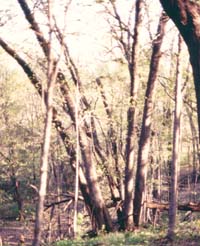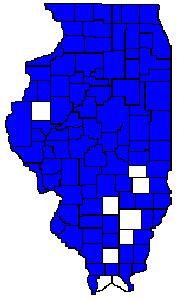 |
| Basswood
(Tilia americana)
Distribution
Map to Right |

Basswood, also referred to as linden or bee tree, is a large tree, reaching heights of 60-90 feet. The trunk is clear (free of hanging branches), cylindrical, and up to two feet in diameter. The crown is broadly rounded and the tree is typically nicely shaped and therefore planted as a shade tree in many places. Basswood grows best in mesic forests on finer soils, although it also grows on the coarser, sandier soils of the Lake Michigan sand dunes in Illinois, for example, and infrequently even on exposed ridges in the far northern part of its range in Canada. It is a component of mesic upland forests in Illinois.
Interesting
Facts
Basswood
has thin bark and is sensitive to fire. At the western part of its range
(eastern North Dakota, South Dakota, Nebraska, and Kansas to northeastern
Oklahoma and northwestern Arkansas) it often grows along firebreaks such
as streams or around ponds.
It is a prolific root sprouter when the main trunk is cut, damaged, or destroyed by fire. It is quite common to see numerous root sprouts at the stump. Whereas basswood is somewhat shade tolerant, it is less so than sugar maple, with which it occurs in mesic upland forests. Basswood is sensitive to fire, but it is one of the least susceptible of the eastern hardwoods to late spring frosts.
Basswood leaves contribute significantly to the nutritional quality of the forest soils. They contain high levels of important mineral nutrients such as nitrogen, calcium, potassium, and magnesium. These nutrients are not withdrawn from the leaves at leaf fall, so they are released to the soil when the leaves decompose, becoming available to the vegetation once again.
Identifying Features
BarkUses
Basswood bark is light gray brown and thin when the tree is young, becoming dark gray or brown with deep furrows and often scaly, flattened ridges when the tree grows older.
Twigs
The twigs are slender and turn from green or deep red in the first year to a grayish, light brown color as they grow older.
Buds
The buds are small (up to 1/4 inch long) oval, smooth, and green to dark red. There are no terminal buds, only lateral.
Leaves
The leaves are alternate and simple. They are distinctive because of their large size (up to 8 inches long and up to 5 or 6 inches broad) and their heart shape. They are pointed at the tip with an asymmetrical base and are coarsely toothed along the edges. The leaf stalk is up to two inches long. The surface of the leaf is dark green and smooth, the underside paler, occasionally with tufts of hair, but mostly smooth.
Flowers
The flowers appear in June and July and are extremely fragrant. They are borne in clusters on a stalk that is attached to a leaf blade-like structure (a bract). They are pale yellow and an excellent source of nectar for honey, hence the common name "bee tree." Bees and flies visit them during the day, and moths at night.
Fruits
The fruits are hard, round, and hairy. They usually contain one seed, but can contain two or even three seeds. Fruits are borne in clusters or singly on a stalk attached to the leaf like structure.
Tilia americana wood is light-weight and extremely close grained. It is used for furniture, children's toys, and paper pulp. It is a favorite choice for hand carving because it is relatively soft and easy to work with. The long fibers of the inner bark were utilized by Native Americans to make strong, tangle-free rope. These fibers have also been used to weave baskets and mats. A very high quality honey is made from Basswood flower nectar, and in some parts of its range, the basswood is referred to as the bee tree. Because of its beautiful shape and large leaves, basswood is commonly planted as an ornamental.